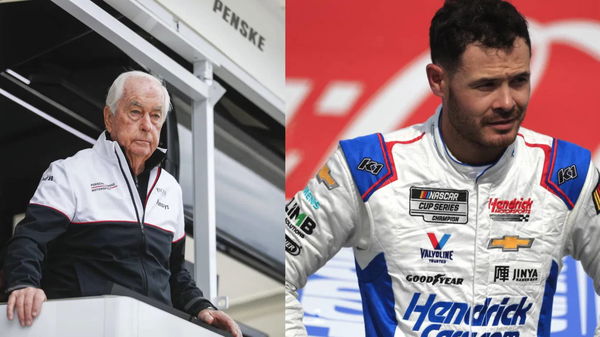
via Imago
Roger Penske and Kyle Larson (Source: IMAGO)

via Imago
Roger Penske and Kyle Larson (Source: IMAGO)
In the hallowed grounds of Indianapolis Motor Speedway, where racing legends are born and broken, Kyle Larson became the latest NASCAR driver to receive a humbling reminder of its unforgiving nature. During Thursday morning’s Indianapolis 500 testing session, Larson’s No. 17 Arrow McLaren Chevrolet found the SAFER barrier in Turn 1, creating a teachable moment that paradoxically may have strengthened his resolve rather than weakened it.
Like NASCAR champions before him—Tony Stewart, Kurt Busch, and others who dared to cross racing’s most prestigious divide—Larson’s debt to Roger Penske’s series’ safety innovations became immediately apparent as he walked away from his first open-wheel crash with a surprising sense of relief. For a driver preparing to attempt the grueling 1,100-mile “Double” on May 25—racing in both the Indianapolis 500 and NASCAR’s Coca-Cola 600 on the same day—this crash might be considered the educational experience he never knew he needed.
ADVERTISEMENT
Article continues below this ad
A learning experience in disguise
The incident occurred during Kyle Larson’s first full lap at qualifying speeds, with engines running extra boost that teams will use during qualifying sessions. “I was starting my qualifying laps there and just got really tight,” Larson explained after being released from the infield care center. “Just a bunch of understeer through Turn 1 and ran out of space off of Turn 1.” The impact broke the right front suspension, sending Larson into a secondary collision with the Turn 2 wall.
“You hate to tear up a really expensive car, but at the same point, I’m happy that I got it out of the way,” Larson said, exhibiting a perspective that might baffle casual observers but makes perfect sense to racing veterans. “I’m honestly, like, a little bit happy that, to now hit the wall, one, and know what it feels like, and two, everything was safe, because, like, the seat, the seat insert, the seat position, all that’s way different than what I have in NASCAR.” This firsthand experience with IndyCar safety systems provided Kyle Larson with invaluable knowledge that no simulator could replicate.
Open-wheel racing, at first glance, looks way more dangerous than stock cars. Larson described the difference, saying, “In NASCAR, I feel like everything surrounds you… In this, you’re kinda like floating a bit more.” Stock cars have a closed cockpit with a roll cage, whereas IndyCars have an open cockpit, making crashes a more daunting thought while getting into them.
One major difference is also that IndyCar has carbon-fiber seats, as the average speed is much higher than NASCAR on traditional ovals, making the impact of crashes much harder on the driver. Having not been in an IndyCar for roughly 11 months since the 2024 Indianapolis 500, Larson admitted feeling “a little rusty” on the first day of testing. He completed 102 laps on Wednesday before Thursday’s mishap cut his critical high-boost testing time short.
More from Kyle Larson on why he wanted (but obviously didn’t try to do) to see what hitting the wall was like. @IndyCarOnFOX pic.twitter.com/iF0whJG3Ez
— Bob Pockrass (@bobpockrass) April 24, 2025
What’s your perspective on:
Can Kyle Larson's crash be the turning point for a historic Indy 500-Coca-Cola 600 double?
Have an interesting take?
Last year’s double-duty attempt ended in disappointment when Larson finished 18th at Indy after a speeding penalty, only to arrive at Charlotte just as rain began falling, preventing him from competing in the NASCAR portion of his planned double. Despite this setback, Kyle Larson’s teams at Arrow McLaren and Hendrick Motorsports now face the challenge of preparing him for qualifying with significantly less high-speed experience than planned. The added complexity of IndyCar’s hybrid engine system—implemented midway through last season—presents another learning curve. “It is a little different car with the hybrid system, so there was things that I didn’t know,” Larson acknowledged.
ADVERTISEMENT
Article continues below this ad
The Indianapolis 500-Coca-Cola 600 double stands as one of motorsport’s most grueling challenges, successfully completed by only Tony Stewart in 2001. For Larson, who entered this test with “less anxiety” than last year, this crash represents just another chapter in his pursuit of racing immortality. His sixth-place ranking on Wednesday’s no-tow timesheet (measuring pure car speed without drafting benefits) showed promising pace before Thursday’s incident.
However, Larson handles challenges in both NASCAR and IndyCar with a practical attitude. Just as he’s gotten used to NASCAR’s “gimmicky” rule changes for events like the All-Star Race, he also accepts the difficulties of learning two very different types of racing at once. This down-to-earth approach will be important as he juggles both racing series in the coming weeks, and for probably the last time in a while.
“In my head, I’m thinking this is probably my last Indy 500 for the near future,” Larson said, hinting that the 2025 attempt might be his final one while racing full-time in NASCAR. “But I am still young, and maybe someday when I’m not full-time Cup and can focus completely on Indy, I’d like to do it again.” Balancing a full-time Cup schedule with IndyCar is no small feat, and there is a reason only one driver could ever complete all 1100 miles of this historic feat. The Cup Series takes priority after this year for Larson, with HMS being championship-less since his 2021 triumph, the driver would be determined to bring his team back to its glory days before venturing into IndyCar again.
ADVERTISEMENT
Article continues below this ad
How do you think Larson will perform at the Indy 500 next month? Let us know in the comments!
ADVERTISEMENT
ADVERTISEMENT
ADVERTISEMENT
ADVERTISEMENT


"Can Kyle Larson's crash be the turning point for a historic Indy 500-Coca-Cola 600 double?"